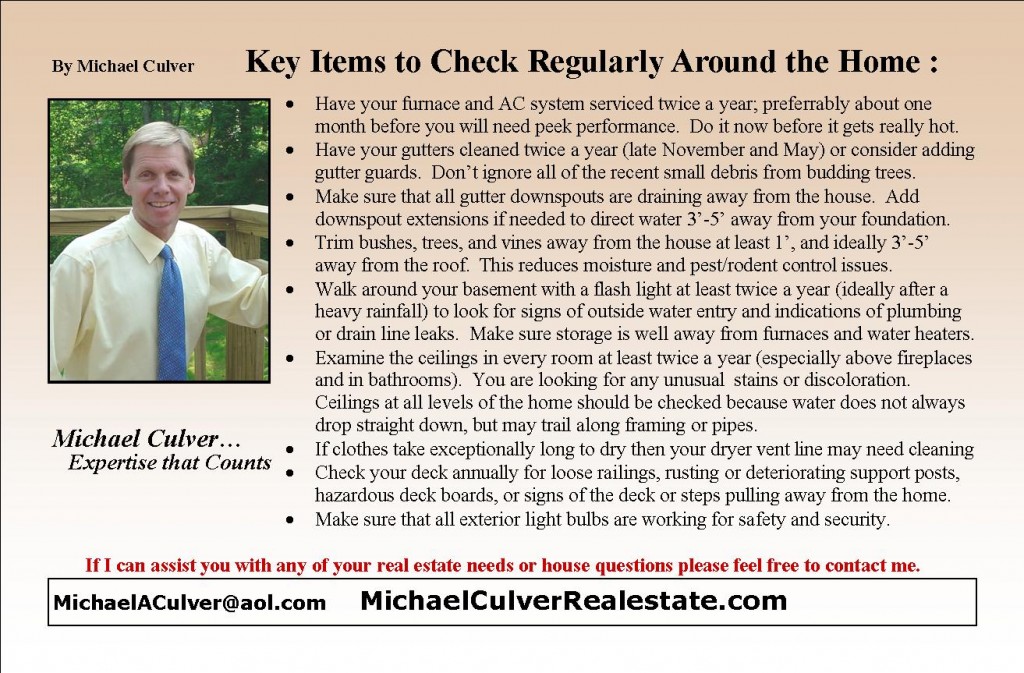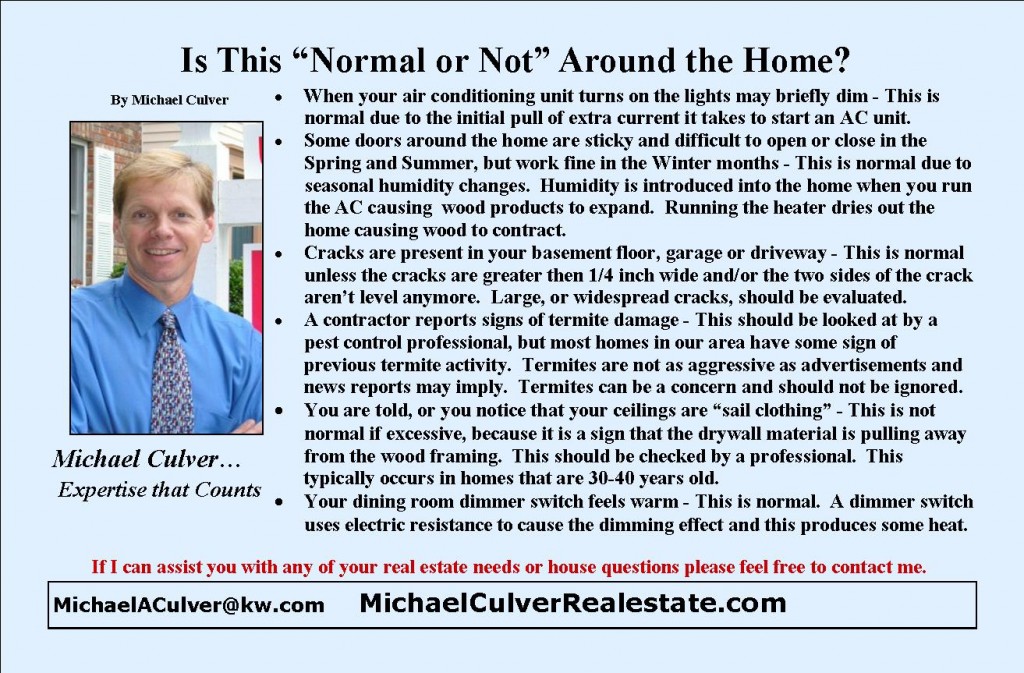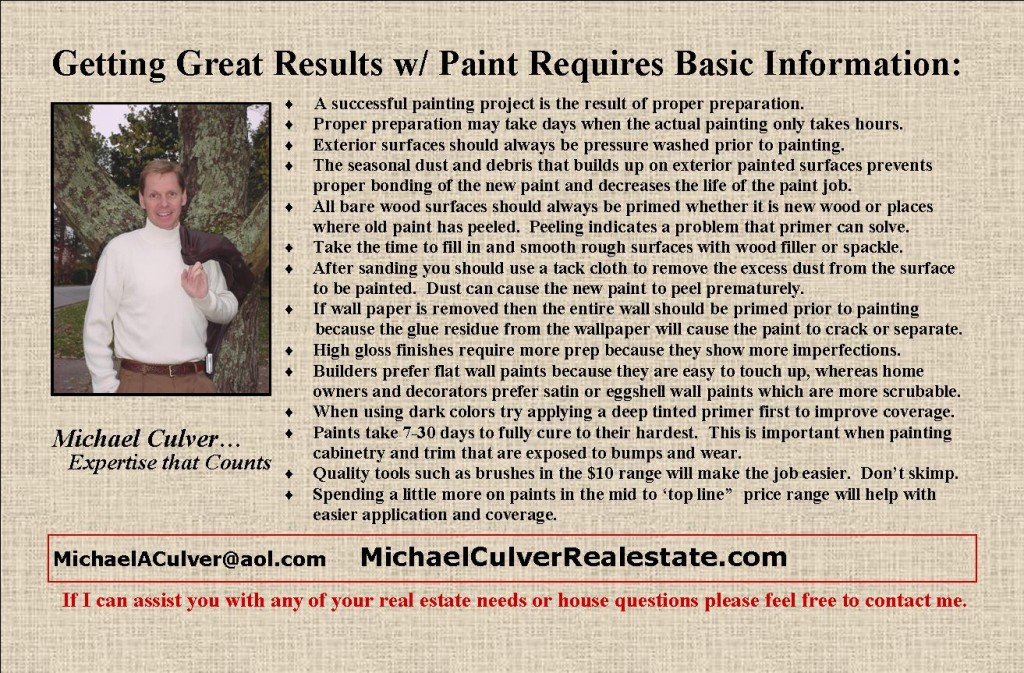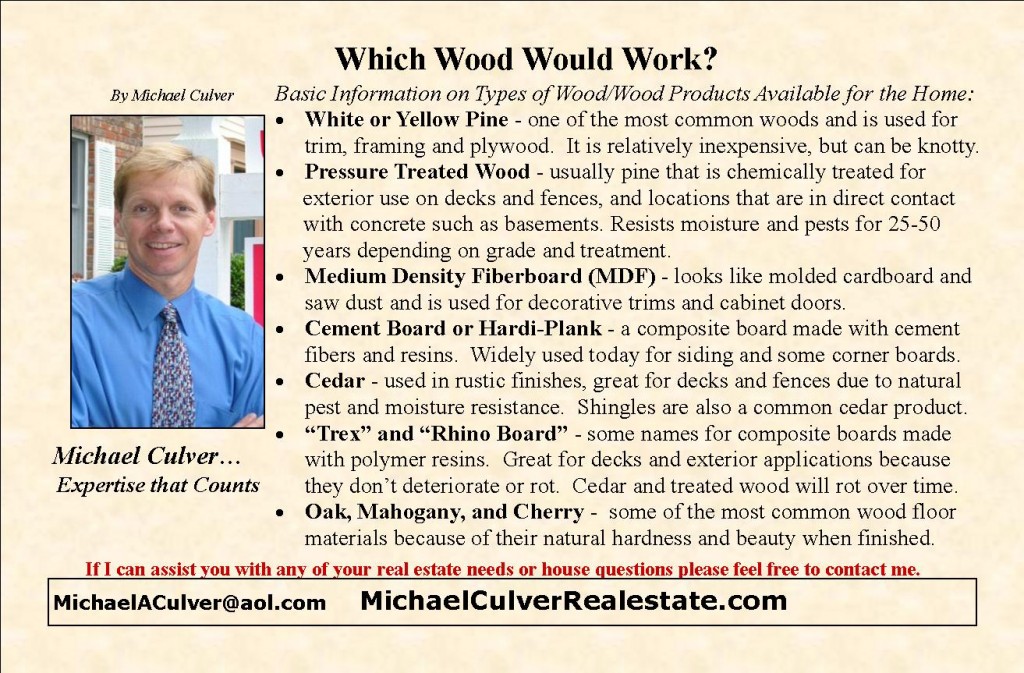b y M i c h a e l C u l v e r
Energy Saving Tips & Tools – Save energy and money!
Home Remedies – Simple Do-It-Yourself Home Remedies
Check Up for the Home – Things to Check Regularly Around The Home
Cold Weather Affects – Affects of Cold Weather on Our Homes
Cold Weather Preparations – Article by Michael Culver
Contractors – Contractor Hiring Basics
Countertops – Basics for Choosing the Right Countertop Material
Doors & Locks – Front Doors & Locks
EcoFriendly Initiatives – Implement EcoFriendly Initiatives
Energy & Money Savings – Energy & Money Savings For the Home
Energy Star – What is “Energy Star” and How Can it Benefit You
Fall & Seasonal Changes – Preparing Your Home for Fall Seasonal Changes
Fireplace Basics – Fireplace Basics for Peace of Mind This Winter
Normal or Not – Is This “Normal or Not” Around the Home?
Older Adults – Housing Options for Older Adult Lifestyles
Paint Basics – Getting Great Results With Paint Requires Basic Information
Systems & Materials – Average Life of Systems & Materials Around the Home
Termite Basics – Coming to Terms With Termites
Windows – Basic Information
Wood Types – Which Wood Would Work?
Preparing Your Home for Cold Weather
Michael Culver, Culver Inspection Services
As the seasons change, so do the things we need to monitor around our homes. The following are just a few of the things you can do to prepare your home for the colder weather ahead.
1) Check your damper and chimney flue to ensure that birds have not made it their summer haven. Also, if you have overhanging trees and you have not used the fireplace for some time, make sure there is no build-up of leaf debris above the damper.
2) Change or clean your furnace filter prior to the heating season. I also recommend a “Test” run of the heat to help get rid of that sometimes annoying start-up odor and help detect early signs of trouble. The flame should be very blue where visible and the unit should not turn off prematurely (“short cycle”). Of course, a pre-season check-up by a licensed technician is always a good idea. This is a slow time for HVAC technicians – why wait until the middle of that cold December night to find out that the heat is not ready for another winter of operation.
3) Periodically check to make sure gutters and downspouts remain free of excess debris once leaves have begun to fall. This is equally necessary for roof surfaces. Excess debris on roof shingles holds moisture, accelerating the rate of shingle deterioration (FYI – most roof leaks appear in the fall as the shingles get cold and brittle).
4) Check your exterior facade for any excessive ivy or vine growth that has gotten up under siding or in around window casing or eaves. This is a great conduit for insects. Also, trim any tree limbs that have grown near to the house at least 3’-5’ away from the roof as this is one of the primary means of access for those rodents seeking a dry warm attic for the winter.
5) Now is a great time to check weather-stripping at windows and doors. We don’t seem to mind a little warm air entering in the summer, but when that cold draft of air blows in, we are sure to take note.
To properly maintain and prepare your home for each seasonal change would be a full-time job, but a little preventative action can save you time and money.
Michael Culver is a full member of the American Society of Home Inspectors (ASHI) and Dunwoody resident.
Coming to Terms with Termites -by Michael Culver
Termite prevention and treatment is a major business in the area we live in. Spring is the time of year when termites are most active. Termites cause homeowners a lot of concern and expense. However, with some basic knowledge and simple precautions this does not have to be the case.
Termites like/need darkness and moisture. Termites return to the soil daily, therefore, it is very important to make sure that gutters and downspouts direct water well away from the structure and that there are no “flat” planting areas directly adjacent to the house. A slight slope away should always be maintained. Bushes should be trimmed around the perimeter and all ground cover, such as pine straw should not be built up to any wood siding or trim. Remove wood and wood debris near to the house such as fire place wood piles. Raw lumber is especially inviting to termites. Today’s building standard is a minimum of 6” clearance from earth to wood, however, in older homes at least 2”-3” clearance is acceptable. Where possible, some of the concrete foundation or brick should be visible.
Termites will build thin mud tunnels when they have to cross a solid surface such as a concrete foundation or part of a brick façade to avoid exposure. They use a combination of soil and waste products to do this. A termite tunnel looks like a thin ivy vine coated with cinnamon. Tunnels are usually perpendicular to the ground. Sometimes these thin mud tunnels can be seen on the inside of a home in the basement or crawl space along joints where the plywood floor decking meets the wood framing. Dirt mounds around the exterior of a foundation are most likely indicative of ant activity rather than termites. Do not remove or break suspected tunnels until a professional has had the chance to evaluate them. Disturbing the tunnels will usually cause the termites to relocate their activity making treatment of the colony more difficult. Don’t worry, it takes a long time for termites to do significant damage.
It is a good idea to have your home inspected annually by a pest control professional, however, it is not essential. When selling your home you will need to have a valid termite letter issued and most companies are willing to provide this letter for a fee usually between $50-$100. A “termite bond” is like an insurance policy. It is not necessary for you to sell your home but it is one more selling point that may set your house apart from the neighbors. A “bond” can cost between $500 and $2000.
If you have any questions about this topic or any other home items, please feel free to contact me.
Regards,
Michael
Termites have a distinct body shape. The body is two parts, whereas, ants have a three part body. Termites look like a figure eight with one elongated end. They can be whitish to black in color(creamy white most prevalent) and are usually about 1/8” – 3/16”. It is easy to mistake ants for termites at a glance but the 2 vs. 3 body parts is key. This time of year termites actually can develop wings and “swarm”. They appear to be flying ants because they acquire wings and a similar coloring temporarily, but again the body type will distinguish them. Termites will not be seen in the open unless they are swarming.


























